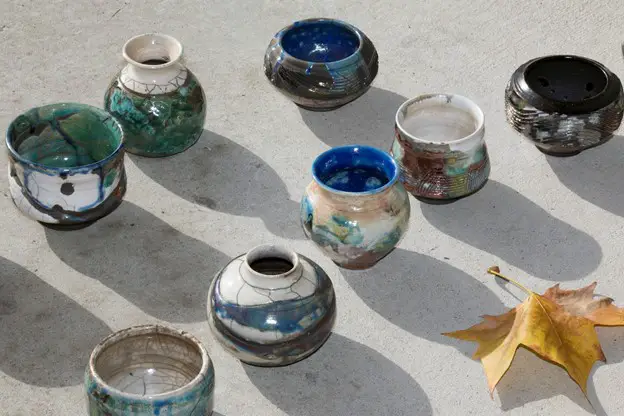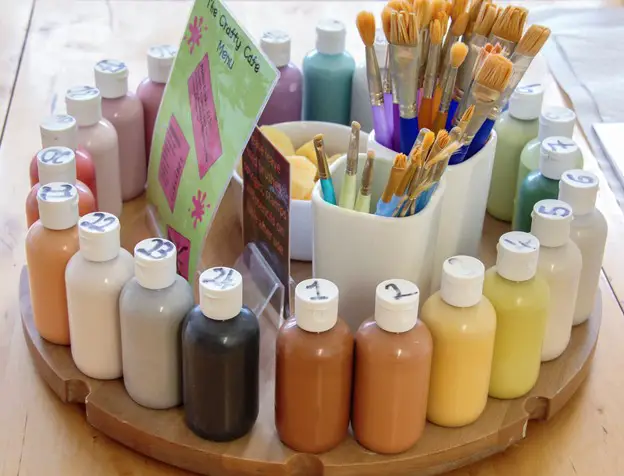The glaze is an important part of most pottery processes that require firing. However, if you fail to store them properly, they might not turn out as good as you expected them to be. But, before you go on and understand the right way to store your pottery glaze, you need to understand what they are and what they are used for!
So, without further ado, let us understand everything about pottery glaze.
What is a pottery glaze?
The glaze is actually a coating or layer of a translucent or transparent substance that is fused with the pottery piece via the process of firing. Pottery glaze can be used for the purpose of coloring, decorating, as well as waterproofing your piece.
Glazing your pottery piece helps the porous surface become almost non-porous which helps hold in liquid items. It also makes the surface tougher. Whether you need a glossy, matte, or brightly colored finish, a glaze can help you achieve it.
Here are the three types of glaze you will use in your pottery endeavors.
Glaze Type |
Firing Temperature |
Cone Number |
Color Type |
| Low-Fire Glaze | 1830 to 1940oF | Cone 06 to 04 | Strong Colors With Less Fire Power |
| Mid-Fire Glaze | 2157 to 2232oF | Cone 4 to 6 | Produces Earthy and Subdued Colors |
| High-Fire Glaze | 2305 to 2381oF | Cone 8 to 10 | Bright Colors |
Now, that you know about glazes, let us understand the best ways to store them.
Pottery Glaze: How to Store it the Right Way?
Pottery glaze is either available in liquid or powdered form that can later be mixed when being used. If you are opting to buy liquid glaze available in the store, the process of storing them would be entirely different than the ones that are available in powdered form.

Dry Powdered Glaze
Well, if you are someone who prefers, store-bought dry pottery glaze, storing it is quite easy. Here are some methods you can try.
1-Storage Bins:
If you have ripped open the original packet in which your dry glaze came in, you would need to store it in an air-tight bin once you are done working with it. Keep in mind, only mix the amount you require and keep the rest within the air-tight bin. Some components present in the dry glaze might be prone to moisture absorption which could make them ineffective in the long run.
So, having access to an air-tight storage bin is ideal to help keep the glaze just as powdery and dry to be used the next time you glaze your pottery piece.
2-Zip-Lock Bags:
While this method might not work with the liquid glaze, this would surely be a great fit for the dry and powdered glazes. You can keep your remaining powder glaze within the zip-lock bag and for additional security, keep this zip-lock bag within a box. Ensure that the bag is kept in a dark and moisture-free place. If your glaze is exposed to moisture, the components within might also develop fungal growth which would be a big waste of precious glaze.
Liquid Glaze
If you aren’t good with mixing, you might be better off getting yourself a liquid pottery glaze. These glazes are easy to use and do not require you to juggle the measurements that are needed with the powdered ones.
One amazing choice of liquid glaze kit is the Mayco ELKIT-1 Glaze for Ceramics that comes in large 4-ounce jars. In this kit, you get 8 amazing colors to experiment with your glazing skills. In case you do purchase it, here are the best ways to store it.
1-Use the Original Box:
Most liquid glaze brands available in the market come with a well-sealed box that is air-tight in itself. To ensure that your glaze is safe even for the next 3-4 or multiple uses, make sure you don’t throw away the original box and take out only the amount of glaze you require for the current project. This will ensure that your glaze is safe and secure.
2-Choose a High-Grade Storage Box:
Keep in mind that your glaze might contain certain metallic elements that might erode your storage can. So, it is better that you pick a container that can tackle any type of erosion such as air-tight plastic bins. Metal boxes might react with the glaze and leech into the glaze changing its potency. Thus, using a high-grade plastic storage box is advisable, and make sure you store it in a place that isn’t exposed to direct sunlight or moisture.
What happens if the glaze freezes?
In case your pottery glaze freezes, the water present in the mix will separate from the solid particles. After the glaze thaws, make sure you mix the same thoroughly. You can either use a mixer or maybe a sieve to ensure that your glaze is reusable, brush-able, and of dipping consistency.
How long can I store my glaze?
If yours is a store-bought glaze, the same can be stored as long as the expiry date mentioned in the packaging. However, there are several factors such as storage, moisture, evaporation, and more that could shorten the overall lifespan of the glaze. In case your liquid glaze dries out, you can easily rehydrate it as required.
In case it’s a homemade glaze, make sure you use it as soon as possible to avoid it from going bad. On the other hand, with dry glaze, you can use it for quite a long time as long as you can keep it away from the moisture-laden area.
Can my pottery glaze rot or go bad?
Glazes, per se don’t actually go bad as they age. However, different ingredients present in the glaze do tend to seep out from the suspension at varying rates. When preparing a glaze that makes use of certain volatile substances like soda ash, make sure you prepare smaller usable batches to avoid wastage.
Keep in mind that the glaze must be mixed only on the day you plan on using it. This helps avoid any drying up or evaporation of certain ingredients in the mix while keeping it effective during the firing process.
Conclusion
Glaze being an important part of the pottery-making process should always be handled with care. In case yours is a store-brought variant, make sure you use it with caution and ensure nothing goes to waste as a good-quality glaze could cost you a worthwhile. Keep in mind that your glaze should always be mixed with the use of distilled water as tap water might contain ingredients such as chlorine or calcium that might change the end results!







